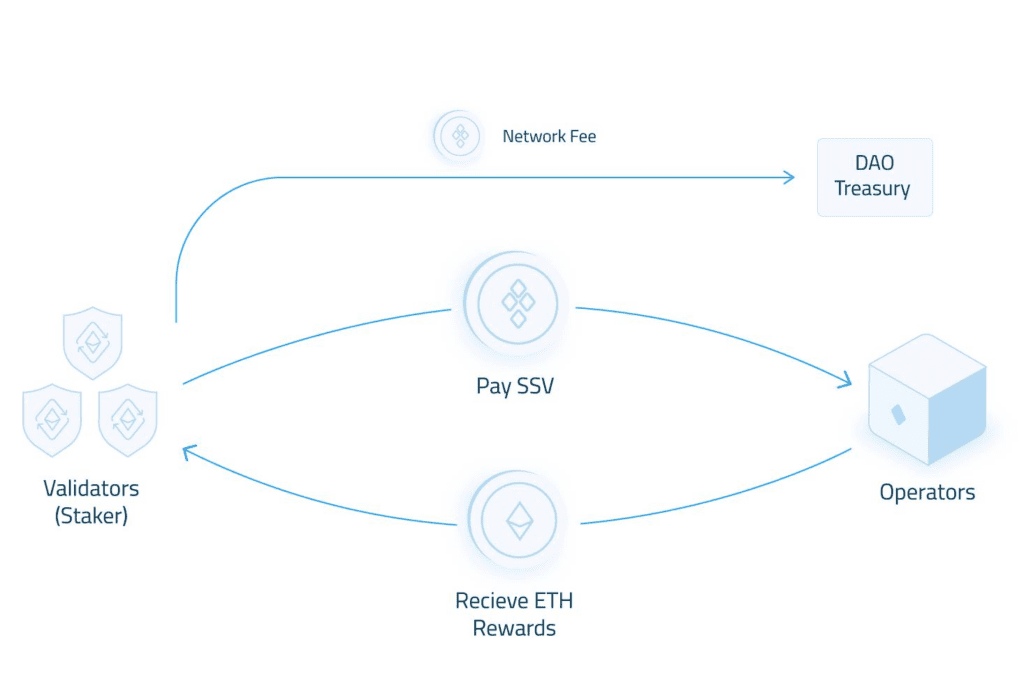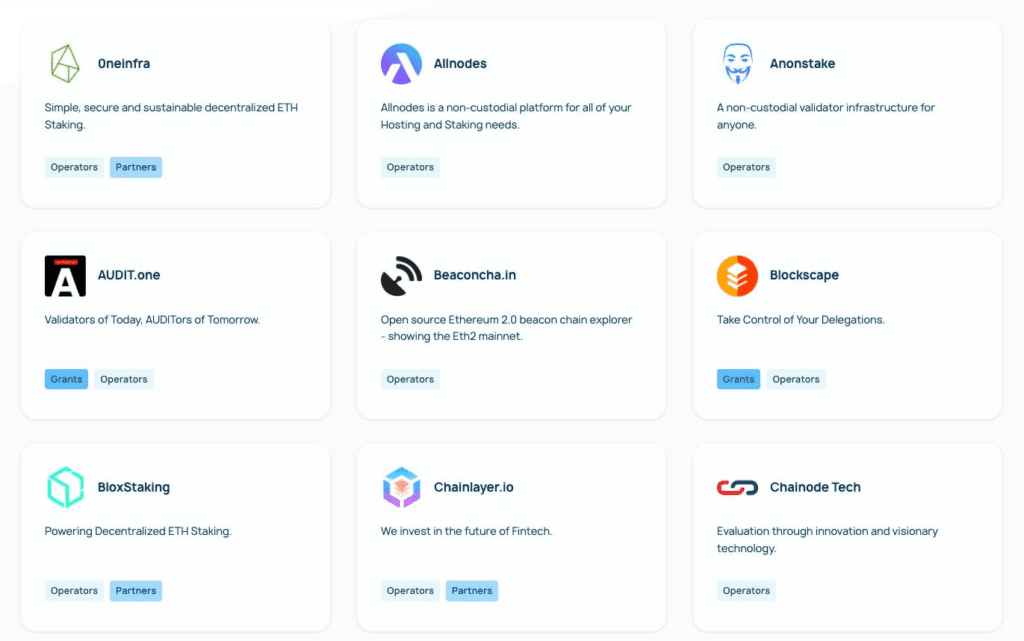Ethereum’s Liquid Staking array is increasingly heating up according to ETH holders’ demand after the Shanghai upgrade. After Lido and Rocket Pool, a project attracting much attention is SSV Network (SSV). Let’s find out what this new solution is and if it can be superior to the previous solutions.

What is SSV Network?
SSV Network is a fully decentralized open-source ETH staking network based on Secret Shared Validator (SSV) technology. SSV is also known as DVT (Distributed Validator Technology) because it provides a simple, open infrastructure to divide and distribute validator keys across multiple KeyShares to run Validator to get the purpose. Ethereum on many nodes needs to be trusted. SSV is the token used in the SSV network.
SSV allows distributors to select multiple cryptocurrency providers by securely separating and distributing their authentication keys among multiple untrusted nodes run by miners. Separating the validator browser into KeyShares and distributing them to various nodes achieves a positive expected performance for Validator reliability. Security is also enhanced, as keys can be securely generated and stored offline as KeyShares represents its Operational Validator.
This KeyShare is distributed to four untrusted nodes run by miners, providing robust, fault-tolerant, active redundancy for Ethereum staking.

With SSV, if KeyShare is unavailable or the operator node fails (due to scheduled maintenance, attack, bug, etc.), the rest of KeyShare will respond and confirm that the program will continue on duty without pausing.
SSV is fully customizable, allowing independent and complex software placement configurations to transform the entire Ethereum staking ecosystem.
The project has raised 10 million USD from several investment funds such as Digital Currency Group (DCG), Coinbase, OKX…
SSV Technology
SSV can be understood as a multi-signature instance combined with a consensus layer (consensus layer). SSV is an intermediary layer between the Beacon Node and the Validator Client.
SSV includes the following components:
Distributed Key Generation: this process generates a set of public and private keys that are computed by Operators running an SSV instance. Each operator will own a unique private key part and guarantee no node. Which operator can audit the entire private key and unilaterally impact staking activity?
Shamir Secret Sharing: this is one of the commonly used techniques in security, created in 1979 by two experts, Adi Shamir, and George Blakely. You can understand this technique through an example: To launch a nuclear missile, usually, there are many atomic activation keys of many senior leaders. Likewise, a secret will be divided into many parts, and to derive that secret, it is necessary to gather all those parts.
SSV will set a certain KeyShares threshold. Only when the minimum set of those KeyShares is sufficient will the Validator perform the required action.
Multi-party computation: multi-party computation algorithm, understood as a way of communication to perform standard calculations involving multiple parties (each party will calculate based on their input data) while still being secure data secured. After distributing the private key, the SSV will use the MPC to ensure the computation is done.
IBFT (Istanbul Byzantine Fault Tolerance) consensus mechanism: this mechanism randomly selects a validator (KeyShares) responsible for suggesting blocks (blocks) and sharing information with others. After enough signatures define a valid KeyShares, the block is added to the chain. With this mechanism, consensus can be achieved even if some operators crash or go offline.
Because SSV provides distributors with a much higher level of security and reliability, they pay fees in SSV tokens ($SSV) to the operators they choose to manage their validators and fees network for DAO.
Highlights of SSV Network

In the Ethereum blockchain, the staking process is always strict, there are rules that even a small deviation will affect the overall network. SSV Network was born to develop the most decentralized and healthy staking environment for everyone.
Ethereum Proof-of-Stake uses validators (guests) to secure the network. In the process of staking ETH, in addition to the rewards validators receive, they also face certain risks.
- Attestation Violation, Proposer Violation.
- In some cases, validators that are not regularly online or offline (with node shutdown) will also be penalized.
- Risk of safety or lack of technical knowledge, all of the above risks will affect the validator’s profit.
To limit these problems, instead of allowing the original node to solve as before. At the SSV Network protocol, operators have more options to run the validator, and to limit failures (e.g. bugs, maintenance, attacks, etc.) and for them to earn rewards.
Participants in SSV
SSV Network will consist of 3 main components: Staker, Operator and DAO.
Staker: is a user who owns ETH with staking needs / staking service parties take advantage of SSV to increase flexibility, security and decentralization when participating in staking.
Operator: is the person who provides the infrastructure, runs the SSV protocol, and is responsible for maintaining the validators and overall health of the SSV Network. Operator will be entitled to a part of the fee (paid in SSV tokens).
DAO: is responsible for administering the SSV Network protocol, the project’s Treasury and project-related proposals through voting in SSV tokens.
Tokenomics

SSV is the project’s native token, with a total of 11,076,871 SSV, the current total circulating supply is 7,085,672 tokens.
Current SSV has the following uses:
- Payment: SSV is used as a payment token (stakers will pay part of the fee to the Operators and to the protocol).
- Governance: SSV holders will be able to participate in voting in the DAO.
Operational status of the project
As I mentioned above, the project is only in the testnet stage, so there are not too many data reflecting the operation situation.
In January 2023, SSV launched a $50 million ecosystem fund, with the goal of supporting Ethereum 2.0 staking technology. Besides, the project also has many big partners, especially validator node services:

Conclusion
Ethereum’s Liquid Staking segment is increasing heating up according to the demand of ETH holders after the Shanghai upgrade. Therefore, it can be seen that Liquid Staking projects are receiving a lot of attention. SSV Network will be open to anyone who wants to run a distributed validator, protecting and optimizing its performance while promoting network-wide decentralization. The low presentation of non-custodial staking services on the Beacon Chain combined with the historical lack of validator client diversity make clear the need for such a system. The Ethereum consensus layer is not immune to central forces, and SSV.network intends to change that by making decentralized staking accessible to everyone.
The idea of SSV allows staking to become more secure, when it is decentralized to Operators and ensures that the network is always up and running even if there is a problem (one of the Operators is cheating, offline…). So, if the project’s mainnet is launched, it will be one of the most anticipated projects in the Staking-as-a-Service array.
DISCLAIMER: The Information on this website is provided as general market commentary and does not constitute investment advice. We encourage you to do your own research before investing.
Join us to keep track of news: https://linktr.ee/coincu
Foxy
Coincu News























